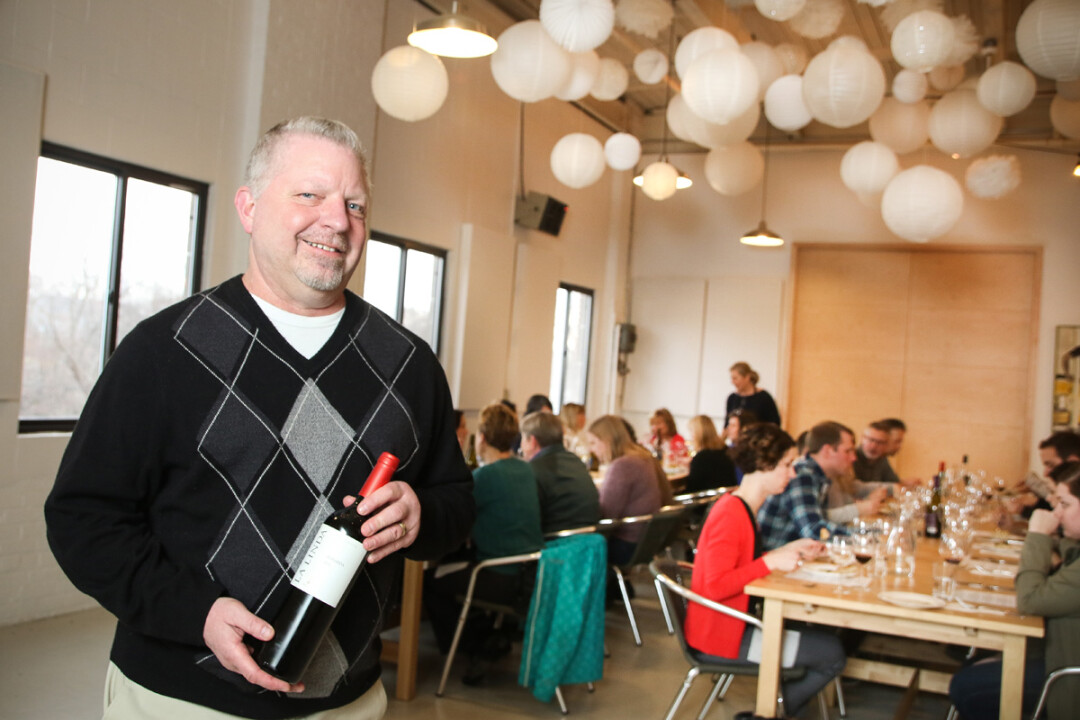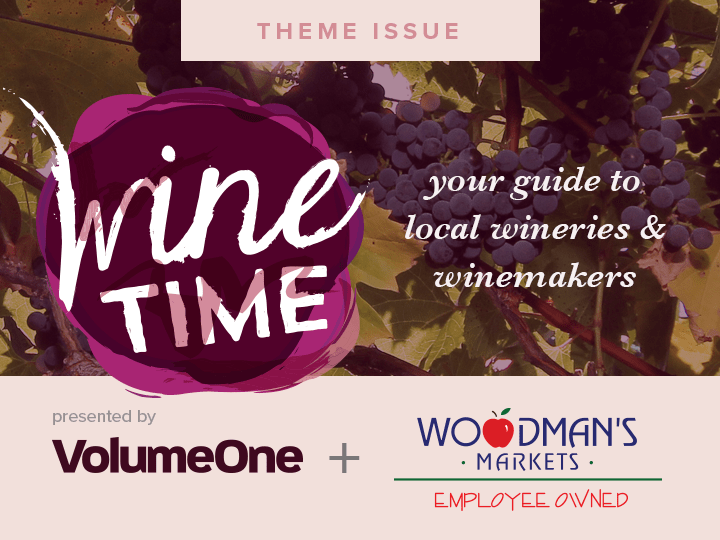William Bernier – a.k.a. the Eau Claire Wine Guy – wants to take the mystery out of wine
Tom Giffey, photos by Andrea Paulseth

Choosing the “right” wine can be intimidating – so intimidating, in fact, that some of us never try anything new or avoid vino altogether. By advising restaurant managers, servers, and diners (whether they’re neophytes or connoisseurs) William Bernier hopes to change this by making wine more accessible for western Wisconsin drinkers.
“Once a person realizes how food and wine can positively affect each other’s flavors, there’s no turning back,” explains Bernier, a wine specialist with Superior-based Saratoga Liquor Co. Among other things, Bernier – who has spent a decade in the wine business – helps restaurants put together their wine lists; trains managers, servers, and bar staff how to sell, serve, and pair wine; and conducts wine dinners, classes, and tastings. It’s via the latter part of his job description that he’s become known as “The Eau Claire Wine Guy.” Through standing monthly wine dinners and other events (see sidebar), Bernier has helped Chippewa Valley diners and drinkers better appreciate the world of wine. We asked Bernier about what questions to ask in the wine aisle, what to have on hand when guests come, and how much to really spend on a bottle.
Volume One: For those of us who aren’t wine connoisseurs but aspire to be, what are some of the basic things we need to know to pick out a good wine, either in a store or at a restaurant?
Bernier: No. 1 is to rely on the staff. They should be able to ask you a few simple questions to help you such as, “What are you eating?” “Do you like sweeter or drier?” and “Red or white?” Reading helps; Wine Spectator and Wine Enthusiast are the best. In a retail setting there are shelf tags that will show if a wine got a good rating. It’s on a 100-point scale, so 90 or better is a good place to start.
If I’m trying to determine my own taste in wine, how should I begin? Should I just start buying bottles to see what I like, or is there a more systematic method you would suggest?
There are places where you can purchase a “flight” of wine, which is usually four or five small pours of different wines of a similar variety. From the Vine and Bye the Willow are good examples of places that offer flights. This is a great way to try several wines at once. Another way is to use friends: Form a wine club, meet once a month or so, and have each person bring a different wine for everyone to try with food. Just make sure you take notes! Of course you can start attending wine dinners and classes around the area. I have quite a few regulars who have developed a nice fondness for wines they never thought they would drink just by learning about them and trying them.
If we have guests coming over and want to be prepared for a range of preferences but don’t want to break the bank or fill a whole wine cellar, what two or three varieties should we have on the shelf?
You actually should have four on hand, two whites and two reds. For white, something on the sweeter side like a Riesling or Moscato, and one more full-bodied and drier; a Russian River Valley Chardonnay would work. For reds, a nice light-bodied red such as a Pinot Noir and a full-bodied red, say a Cabernet from Sonoma or Napa.
For those of us who drink slowly, how long can we keep an open bottle of wine around? Does it always have to be refrigerated?
I get this question all the time. You should invest in a preservation system such as a Vacu Vin or an inert gas spray. Look for these types of things at The Coffee Grounds in Eau Claire. They can help you find the right one for your needs and show you how to use it. Yes, being refrigerated will help wine live longer – includes your reds as well. For a white wine, you should get anywhere from seven to a max of 10 days out of the bottle, depending if you just cork it or use one of the above-mentioned systems. For reds, typically no more than five days. One thing I tell people is to refrigerate the red and let it sit out on the counter and warm up for 30 minutes or so when you want to drink it. This will help preserve the freshness much more than just leaving it sit out in your warm kitchen.
Wisconsin is certainly not a high-profile wine region like Bordeaux or Napa, but there are nonetheless some good wines made here. What are some of your favorites?
There are a lot of people making wine in Wisconsin. Some are having some nice success and some are still learning, but I would have to say Wollersheim is by far my favorite Wisconsin winery.
How do Wisconsin wines stack up versus others in the Midwest or nationwide?
The University of Minnesota is recognized as one of the top wine grape research programs in the country and has done an amazing job of breeding grape varieties that stand up to our harsh climate. That being said, it is going to take some time before Wisconsin is recognized as a premier wine producing region. Wisconsin wines do hold their own very well versus other Midwest wines I’ve had. As for nationwide, the growing regions of the West Coast, upstate New York and now Virginia really have all the right pieces in place for what they do: climate, soil, experience. It will take time, but through trial and error and the continuing efforts of the U of M, Wisconsin will eventually have its niche in the wine world.
In a beer-loving place like Wisconsin, wine has sometimes been seen as an elite beverage or something only for special occasions. What’s your best pitch as to why everyday folks should be drinking wine on an everyday basis?
Right now the hottest price point for wine in retail is the $10-to-$20-a-bottle range. You don’t have to pay a lot of money to drink a good wine. I think most people just haven’t tried the right wine or are so intimidated by all the choices that they will stick with what they know rather than experiment with wine. Once a person realizes how food and wine can positively affect each other’s flavors, there’s no turning back. Wine also has some heart-healthy benefits that other drinks don’t when consumed in moderation.
How do I know if I’m paying too much for a bottle of wine?
If your rent check bounced. Seriously, referring to my above answer, you don’t have to pay a lot for a good bottle. If you aren’t sure, ask. Tell the person helping you the max you want to spend and let them guide you. If you are shopping at a place where they can’t answer your questions, shop somewhere else.
What’s the most expensive wine you’ve ever tasted?
Penfolds Grange Shiraz, which typically will sell for around $600 a bottle and is usually four to five years old before it is released.
Was it worth it?
It’s a phenomenal wine, a collector’s item. Very much worth it.
WHERE’S THE WINE GUY?
William Bernier holds three standing monthly events:
• First Wednesday of every month: Wine dinner at Forage Eau Claire with Chef Michele Thiede.
• Third Wednesday of every month: Wine dinner at The Local Lounge Eau Claire with Chef Joey Meicher.
• Last Wednesday of every month: Wine dinner at Johnson’s Crossing north of Holcombe with Chef Andrew Johnson.
Bernier also occasionally holds wine dinners at Zanzibar in Menomonie, Shanghai Bistro in Hudson, Pokegama Inn in Chetek and classes at From the Vine in Eau Claire and Bye the Willow in Chippewa Falls.
Learn more online at facebook.com/EauClaireWineGuy



